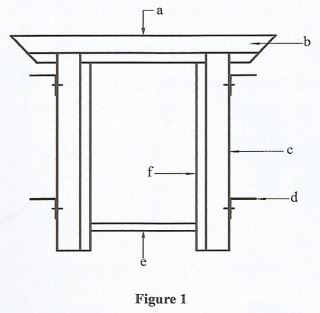| |
SECTION A |
|
| 1 |
- Two reasons for removing vegetable soil from a construction site are:
- To ensure soil which is rich in human that contains ingredients responsible for vegetable growth does not exist on the area where the building is to locate
- To create a suitable base and avoid uneven building settlement.
- To reduce chemical or sulphate attached on the building in terms of walling units being affected and reduce the creation of efflorescence on the wall.
- Reduce termite attack.
- Create space.
- Identify soft spots.
- Prevent vegetable growth. Any 2 x 1 = 2 marks
- Building construction
- Involves the physical activities on site which involve erection of structures, cladding, external finishes, formwork, fixtures and fittings of service installations.
|
(2marks)
(1mark)
|
| 2 |
- Strap Hinge

Correct sketch-1 mark
Proportionality - 1 mark
(any other correct drawing) 2 marks
- Formation of plaster dots before plastering.
- They help to make the required plaster thickness.
- Helps to achieve the required wall alignment whether diagonal or straight.
- Makes the plaster work to be completed faster.
- Helps to attain the required wall plumpness.
Any 2 x 1 = 2 marks (2 marks)
|
(2 marks)
(2 marks)
|
| 3 |
-
- Apart from huts or caves one other form of shelter was the pitching of wooden stakes/sticks upright, they were closely placed together such that no animal or any intruder could penetrate.
- Leaves from the branches were used to cover all round and at the top animal hides and skins could be used to cover. This would fend off the rain and keep the shelter warm.
- This type of shelter was mainly found in forested areas where tree twigs and or leaves could be found in abundance. Naming 1, explanation 2 (3 x 1 = 3 marks)
|
(3 marks) |
| 4 |
- Protective wear
-
- Head-Helmet
- Hands - Gloves
- Feet-Safety boots/gum boots
- Eyes - Googles 4 x ½ = 2
- Reasons for using d.p.c appropriately:
- Prevent moisture from sipping through the wall.
- To increase the paint life on walls
- To prevent dank and musty smell which the ground produces die-join/ to untreated mold.
Any 2 x 1=1
|
(2 marks) |
| 5 |
- To sketch of a cross-section of a PVC tiles floor finish from the hardcore.
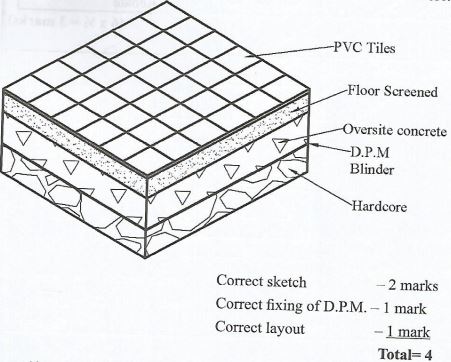
Accept if the sketch is drawn in orthographic projection
|
(4 marks) |
| 6 |
- Advantages:
- Simple to use - Does not require any calculations.
- Can be applied to large buildings.
- Adjustment in the event of an error is simple and quick. Any 2 x 1
|
(2 marks) |
| 7 |
Qualities of the following workshop attire:
- Goggles
- Should be strong to prevent any object that may hit it.
- Clear view -- should have a clear view for one to see through.
- Durable - Should be able to be used over a long period of time without breaking.
Any 2 x 1 = 2 marks
- Workshop boots.
- Be hard enough to protect the feet in case of any heavy item from the top.
- Have a strong sole to protect the owner from being burnt or pierced by any sharp object on the ground.
- Not easy to break when hit by a heavy object - sturdy.
- Have metal cap
- Not heavy
|
(2 marks)
(2 marks)
|
| 8 |
- Parts of a door frame. Labels are as follows:-
| (a) - Head |
C-Jamb or post |
E-Temporary steady |
| (b) - Horn |
D-Metal anchor |
F-Rebate |
(6 x 1⁄2 = 3 marks)
- Strip foundation footing.
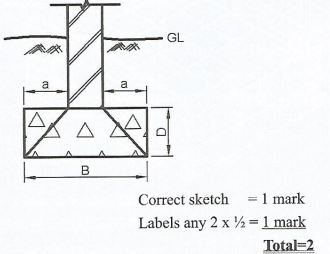
|
(3 marks)
(2 marks)
|
| 9 |
- Three advantages of PVC pipes
- Cheaper in terms of cost
- Do not corrode
- Easy to assemble
- Long lasting
- Light in weight
(any 3 x 1 = 3 marks) Accept any other correct response
- Difference between a gable roof and lean to roof
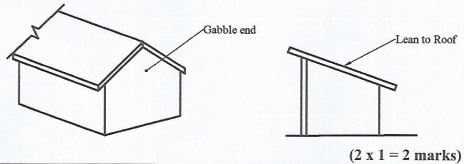
|
(3 marks)
(2 marks)
|
| 10 |
To construct a pipe of 15mm and a length of 50mm diameter to diameter
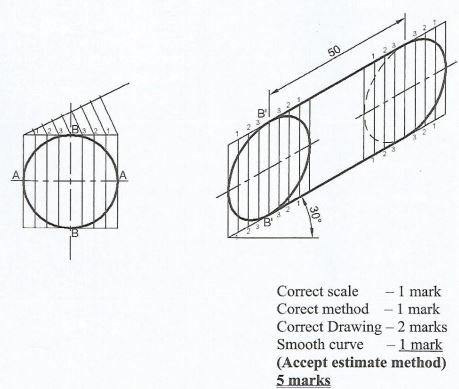 |
(5 marks) |
| |
SECTION B |
|
| 11 |
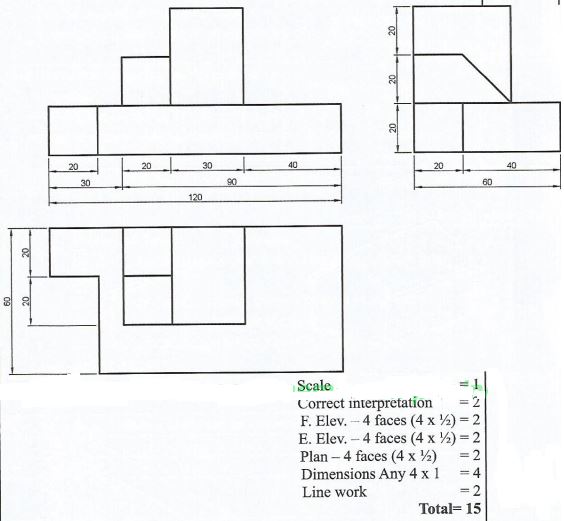 |
(15marks) |
| 12 |
- Leveling the trench bottom using boning rods:
- Leveling the trench bottom using boning rods, start by digging the trench to the required depth. Once the desired depth is reached, make the trench bottom base roughly level. Drive the first peg to the approximate depth required fix a boning rod on top and move to the far end and fix another peg and using a sighting line, then fix the last peg to the required depth. Fill in the middle peg through the sighting line to produce its required depth in readiness to pour in the concrete to attain heights in order to produce the concrete depth necessary for the concrete bed.
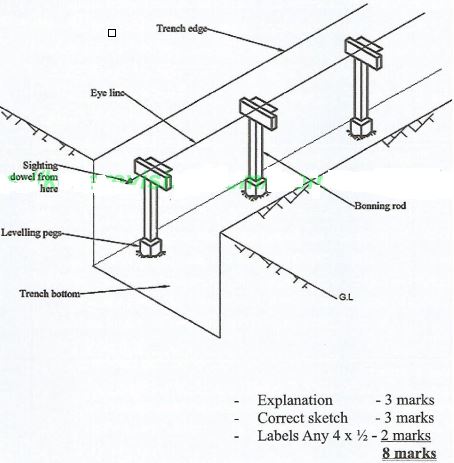
- Procedure of casting an in situ lintel.
- Prepare the soffit of opening by using steel or timber. (formwork) Prepare the reinforcement in the ground.
- Place the reinforcement bars into the box and align.
- Batch the concrete material to the required ratios.
- Mix the concrete to the required standards.
- Pour the concrete mix into the box(formwork).
- Tamp/rod the concrete to compact appropriately.
|
(8 marks)
(7 marks)
|
| 13 |
- Difference between a turning piece and a centre piece.
Turning piece
- This is a single piece of timber used to bridge an opening when forming an arch. When it is removed the shape of the arch is achieved. It is therefore formed in the shape of the arch required. It uses less material compared to the centre piece. It is cheaper in cost; hence easier to make. Take a shorter duration to prepare when compared to the centre piece. 6 items x ½ = 3 marks (Accept a sketch if provided)
Centre piece
- Is a two ribbed member which is stronger than the turning piece. The two ribs are joined by laggings. It is therefore bigger and heavier than the turning piece. It is more difficult to make and more costly as it requires more materials to make. It requires a skilled personnel to make. Any 6 x 1⁄2 = 3 marks (Accept a sketch if used)
- Scaffolding members.
- Standard: These are upright members positioned in alignment and is placed parallel to the wall. All key members are tied onto it to secure other parts.
- Ledgers: These are horizontal members which connect the rows of standards. They are secured onto the wall for stability. Other members like toe boards are fixed onto it.
- Putlogs: These are members with shorter lengths with one end flattened to enter the holes dug in the walls. They are then tied onto the standards to secure the scaffold as it creates the required rigidity and the necessary stability expected for the scaffold user.
3 x 2 = 6 marks
- Functions of soak away pit.
- Point of collection of foul water.
- Helps to hold the effluent from the septic tank before it is discharged into the surrounding.
- Help to discharge in small quantities of purified effluent into its surrounding or where guided. Any 2 explained - 2 x ½ = 3 marks (3 marks)
|
(3 marks)
(3 marks)
(6 marks)
(3 marks)
|
| 14 |
- Four key persons involved in the implementation of a building construction project:
- Client - Architect - Contractor - Clerk of works
- Quantity surveyor - Engineers (Structural, Electrical and Mechanical)
Any 4 x 1 = 4 marks
- Standard mixes of concrete:
- Concrete columns - 1:2:4
- Foundation concrete - 1:3:6
- Upper (suspended) floor slab - 1:2:4
- Concrete window cill- 1:2:4 4 x 1⁄2 2 marks (2 marks)
- Procedure of preparing the surface of a cracked wall peeling off paint.
- Identify the palster cracks
- Clean the cracks with a dry brush
- Sprinkle water onto the cracked surface
- Use filler to fill all the cracks
- Allow the filler to dry
- Sand the wall afresh and clean it with a brush and a piece of cloth
- If some cracks are still noticed use filler to patch them up
- Sand a fresh again
- Clean the surface using a brush
- Clear with brush or a blower in readiness for paint
|
(4 marks)
(2 marks)
(9 marks)
|
| 15 |
-
- Pitch refers to the slope or inclination which drains off water from the roof safely to the ground. It is therefore the inclination of the roof to the horizontal.
- Two methods of obtaining the pitch are:
Pitch = Rise
Span
Fixed angle of slope e.g 22½°, 30° or 45°
- CONCRETE INSPECTION CHAMBER
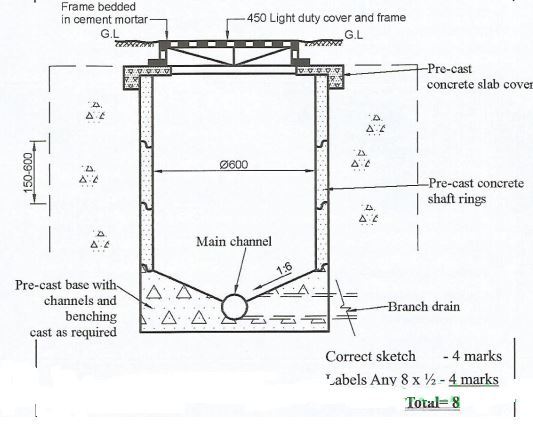
- Factors that govern the method to be used when excavating a trench
- Size of the area to be excavated.
- Volume of the soil to be excavated
- Type of soil on the site
- Time factor
- Cost implications
- Availability of equipment Any 3 x1 = 3 marks
|
(2 marks)
(1 marks)
(1 marks)
(3 marks)
|



